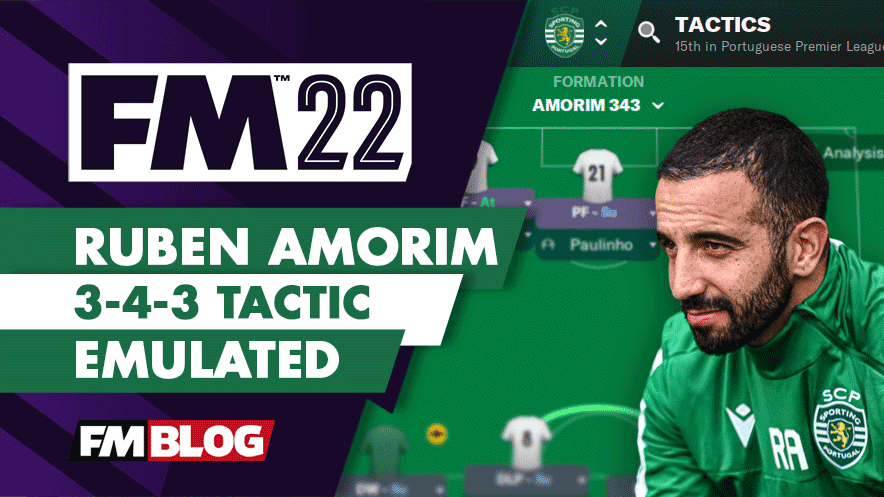Europe’s next supercoach, Ruben Amorim's title-winning tactic emulated in Football Manager 2022.
Ruben Amorim gained attention across Portugal and Europe when he masterminded Sporting’s title charge in 2020-2021. The Lisbon side are traditionally one of Portugal’s big three but had endured
a 19-year title drought before Amorim’s side completed a league, and Taca de
Liga double in his first season in charge. Despite spending most of his career
with Sporting’s city rivals Benfica - and having only two months of first-team
management under his belt at the time - Sporting paid Braga approximately €10million for Amorim’s services, making him the 3rd-most expensive manager after André Villas-Boas and Brendan Rodgers. While this was seen as a risky move at the time, the gamble has
paid off, and Amorim’s tactical astuteness has taken Sporting back to the
pinnacle of Portuguese football.
Amorim is rigid in his dedication to three at the back, with his Sporting side playing almost every minute of his career thus far in either a 3-4-3 or a 3-4-1-2. That commitment to shape is the only thing rigid about this tactic, however, as Amorim relies on the fluidity of movement to create overloads and exploit space. In their title season, Sporting completed the fourth-most passes in the league, with the second-highest accuracy, but crucially they did not pass the ball simply for possession retention. This is still a very vertically-minded side, who like to get the ball forward and attack the opposition box.
Out of possession, the way in which Sporting press is fascinating, in that they largely buck the counter-pressing trend. This side does not pounce as soon as they lose the ball, aiming to win it back quickly; rather, they fall back into their defensive shape before the centre forward leads the pressure on the opposition back line. By falling back into a defensive shape which naturally provides a lot of central stability, they tend to force the opposition to move the ball to their full-backs, where Sporting’s wide forwards and wing backs look to pounce.
Sporting’s shape is also conducive to some beautiful attacking moments in transition. When the ball is recovered by the defence, the technically gifted centre-backs are all capable of bringing the ball out from the back, and typically have no shortage of passing options as the rest of the team stretches the play. When the ball is recovered by the midfield, having three strikers - as opposed to the usual one central striker and two wingers - ensures there are plenty of options for an outlet pass. The nature of the strikers’ movement makes them incredibly difficult for the opposition to mark or to know which spaces require coverage.
Ruben Amorim's Philosophy
Amorim is rigid in his dedication to three at the back, with his Sporting side playing almost every minute of his career thus far in either a 3-4-3 or a 3-4-1-2. That commitment to shape is the only thing rigid about this tactic, however, as Amorim relies on the fluidity of movement to create overloads and exploit space. In their title season, Sporting completed the fourth-most passes in the league, with the second-highest accuracy, but crucially they did not pass the ball simply for possession retention. This is still a very vertically-minded side, who like to get the ball forward and attack the opposition box.
Out of possession, the way in which Sporting press is fascinating, in that they largely buck the counter-pressing trend. This side does not pounce as soon as they lose the ball, aiming to win it back quickly; rather, they fall back into their defensive shape before the centre forward leads the pressure on the opposition back line. By falling back into a defensive shape which naturally provides a lot of central stability, they tend to force the opposition to move the ball to their full-backs, where Sporting’s wide forwards and wing backs look to pounce.
Sporting’s shape is also conducive to some beautiful attacking moments in transition. When the ball is recovered by the defence, the technically gifted centre-backs are all capable of bringing the ball out from the back, and typically have no shortage of passing options as the rest of the team stretches the play. When the ball is recovered by the midfield, having three strikers - as opposed to the usual one central striker and two wingers - ensures there are plenty of options for an outlet pass. The nature of the strikers’ movement makes them incredibly difficult for the opposition to mark or to know which spaces require coverage.
How does this look on FM22?
As above, I find the key to this tactic is three strikers rather than one striker and two wingers or inside forwards. This is for two reasons: it's incredibly difficult for the opposition to know how to cover; and I find having your wide forwards with tailored player instructions more closely matches the real-life movements of Sporting’s front three. Defensively, this is also more useful in stabilising the centre than having two wingers who will naturally look to do their defending closer to the touchline.
Regrouping and forcing the opposition outside - where you trigger your press - is also a hallmark of this Sporting side, and while it may be different from your usual high pressing tactics, it’s very effective if your players have the mental attributes to execute it correctly.
All in all, I hope you enjoy using this tactic. I believe this is a very faithful recreation of one of the most fascinating tactical systems in the world, and I hope you can enjoy the same success as Ruben Amorim’s Sporting.




















